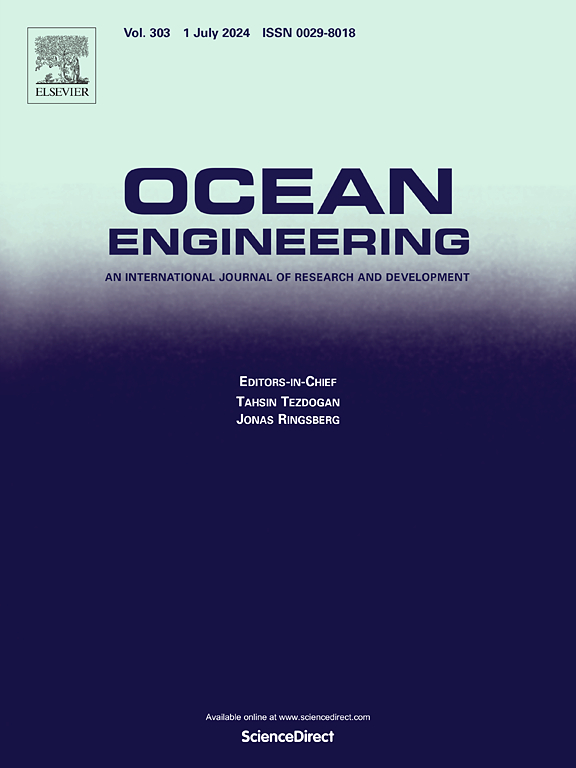间歇或正弦胸鳍配合对海豚自发俯仰行为的水动力影响的数值研究
IF 5.5
2区 工程技术
Q1 ENGINEERING, CIVIL
引用次数: 0
摘要
海豚复合鳍结构具有高度的协调性和专门性,是海洋工程和仿生力学领域的重要研究课题。本研究旨在从计算流体物理的角度探讨胸鳍正弦和间歇拍动对海豚自发俯仰行为的促进作用。采用混合网格嵌入方法结合动态重叠技术处理海豚胸鳍的局部柔性变形和身体的刚性平移运动。结果表明,根据自然界的生物力学原理,胸鳍的加入,无论是间歇性还是正弦模式,都可以有效地纠正海豚的原始航向,从而产生一个非常类似于非线性锯齿形扇形的轨迹。对于正弦模态,胸鳍上升力系数CFPy在一个周期内的上升和下降阶段表现出不对称性。对于间歇模式,CFPy在一个周期内显示单峰脉冲特性。通过对三个具体性能参数的定量分析,我们得出正弦模式具有较高的稳定性和可持续性,而间歇模式在优化轨迹半径和能量转换方面表现出色。本文章由计算机程序翻译,如有差异,请以英文原文为准。
Numerical study on hydrodynamic effects of intermittent or sinusoidal coordination of pectoral fins to achieve spontaneous nose-up pitching behavior in dolphins
The composite fin structure of dolphins is highly coordinated and specialized, making it an important research subject in the fields of marine engineering and biomimetic mechanics. This study aims to explore the promoting effects of the sinusoidal and intermittent flapping of the dolphin's pectoral fins on its spontaneous nose-up pitching behavior from the perspective of computational fluid physics. We adopt a hybrid mesh embedding method combined with dynamic overlapping techniques to handle the local flexible deformation of the dolphin's pectoral fins and the rigid translational motion of the body. The results indicate that, following the principles of biomechanics in nature, the inclusion of pectoral fins, whether in intermittent or sinusoidal mode, can effectively correct the dolphin's original heading, resulting in a trajectory that closely resembles a nonlinear, sawtooth-shaped fan pattern. For the sinusoidal mode, the ascent force coefficient CFPy of the pectoral fins exhibits asymmetry between the rising and falling phases within a cycle. For the intermittent mode, CFPy displays a single peak pulse characteristic within one cycle. Through the quantitative analysis of three specific performance parameters, we conclude that the sinusoidal mode provides high stability and sustainability, while the intermittent mode excels in optimizing trajectory radius and energy conversion.
求助全文
通过发布文献求助,成功后即可免费获取论文全文。
去求助
来源期刊

Ocean Engineering
工程技术-工程:大洋
CiteScore
7.30
自引率
34.00%
发文量
2379
审稿时长
8.1 months
期刊介绍:
Ocean Engineering provides a medium for the publication of original research and development work in the field of ocean engineering. Ocean Engineering seeks papers in the following topics.
 求助内容:
求助内容: 应助结果提醒方式:
应助结果提醒方式:


